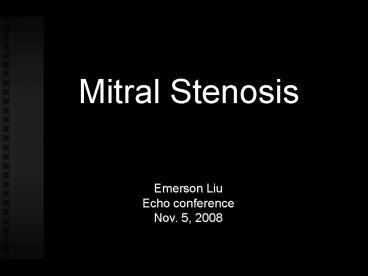Mitral Stenosis - PowerPoint PPT Presentation
1 / 37
Title:
Mitral Stenosis
Description:
These are BMV, open commissurotomy, and mitral valve replacement. Because clinical trials have found BMV to be superior to closed surgical commissurotomy, ... – PowerPoint PPT presentation
Number of Views:2856
Avg rating:3.0/5.0
Title: Mitral Stenosis
1
Mitral Stenosis
Emerson Liu Echo conference Nov. 5, 2008
2
Etiologies
- Rheumatic Fever
- Congenital MS
- Rare complication of
- carcinoid, SLE, RA,
- mucopolysaccharidoses,
- Whipple, amyloid deposit
- MAC may extend onto leaflet bases
- Obstructive physiology myxoma, IE, cor
triatriatum - Cafergot Toxicity
3
MV Orifice Area
- Normal 4 - 6 cm2
- Mild stenosis 1.6 - 2.5 cm2
- Mod (usu Asx at rest) 1.1 - 1.5 cm2
- Severe 1.0 cm2
4
S1 S2 OS
S1
- First heart sound (S1) is accentuated and
snapping - Opening snap (OS) after aortic valve closure
- Low pitch diastolic rumble at the apex
- Pre-systolic accentuation (esp. if in sinus
rhythm)
5
Pathophysiology
Right Heart Failure Hepatic Congestion JVD Tricuspid Regurgitation RA Enlargement ? Pulmonary HTN Pulmonary Congestion LA Enlargement Atrial Fib LA Thrombi ? LA Pressure
RV Pressure Overload RVH RV Failure LV Filling
6
Clinical Presentation
- Dyspnea
- Hemoptysis
- Chest pain
- Palpitations and embolic events
- Ortner syndrome hoarseness due to
- compression of the left recurrent laryngeal
- by dilated LA, tracheobronchial LN, and PA
7
Role of Echocardiography
- Diagnose Mitral Stenosis
- Assess valve morphology thickness, mobility,
degree of calcification, extent of subvalvular
involvement - Assess hemodynamic severity mean gradient, MV
area, PAP - Assess RV size and function.
- Assess suitability for percutaneous valvuloplasty
- Diagnose / assess concomitant valvular lesions
- Reevaluate pts with known MS with changing
symptoms or signs, and F/U of asx pts with
mod-severe MS
8
M-Mode
- 1. Thickened Mitral leaflets
- 2. Decreased E to F slope (increased EPSS)
- 3. Diastolic anterior motion
of posterior leaflet - 4. Abnormal septal motion
- 5. Left Atrial enlargement
- 6. Left Atrial thrombus
- 7. RV dilatation
- 8. Pulmonary hypertension
- 9. Small LV
9
Thickened Leaflets in Mitral Stenosis
Mild Moderate
Severe
10
Increased EPSS
Mild Moderate
Severe
11
Continuity equation
12
(No Transcript)
13
Diastolic Anterior Motion of Posterior Leaflet
14
2-D Echo Findings in MS
- 1. Thickened (gt 3 mm) and calcified mitral
leaflets and subvalvular apparatus. - 2. Hockey-stick appearance of the anterior
mitral leaflet in diastole
(long-axis view). - 3. Fish-mouth orifice in short-axis view.
- 4. Immobility of posterior leaflet.
- 5. Increased Left Atrial Size.
- 6. Small Left Ventricle.
15
Rheumatic MS
16
Rheumatic MS
17
(No Transcript)
18
Pitfalls
- Pressure Gradient
- Intercept angle
- beat to beat variability in AF
- Dependence on transmitral volume flow rate
- (exercise, coexisting mitral regurgitation)
19
Mitral valve Area
20
2D planimetry
21
Pitfalls
- 2D planimetry
- Image orientation
- Tomographic plane
- 2D gain settings
- Poor acoustic access
- Deformed valve anatomy post-valvuloplasty
22
(No Transcript)
23
220 t½
MVA
24
(No Transcript)
25
Pitfalls
- T½ Valve Area
- Definition of Vmax and early diastolic slope
- Nonlinear early diastolic velocity slope
- Sinus rhythm with a wave superimposed on early
diastolic slope - Afib Hemodynamics averaged over 5-10 cycles
- Influence of coexisting AR
- Changing LV and LA compliances (post
commisurotomy)
26
Continuity equation
MVA x VTI (ms jet) transmittal SV
LVOT CSA x VTI
in the absence of MR
27
PISA Method
28
Pitfalls
- Continuity equation
- Accurate measurement of transmitral SV
- parallel intercept angle
- without significant MR
29
TEE
- Class IIa
- 1. Check for LA thrombus in patients
- considered for PBV or cardioversion.
- 2. Evaluate valve morphology and
- hemodynamics when transthoracic
- echo is suboptimal.
- Guide trans-septal
- puncture, or position
- of balloon, during PBV
30
Natural History
- Progressive, lifelong disease
- Usually slow stable in the early years
- Progressive acceleration in the later years
- 20-40 year latency from rheumatic fever to
symptom onset - Additional 10 years before disabling symptoms
31
(No Transcript)
32
Exercise Hemodynamics
- For patients who have exertional symptoms and
in whom resting hemodynamics do not clearly
indicate severe MS. - With fixed valve area, ? CO and HR will ?
transmitral gradient, LA pressure an PA pressure
33
Percutaneous Mitral Balloon Valvotomy
- Class 1 Indications
- Symptoms (NYHA II, III, IV), MVA 1.5cm², and
valve morphology favorable for percutaneous
balloon valvotomy, in the absence of left atrial
thrombus or moderate to severe MR.
34
Wilkins Score
35
Percutaneous Commissurotomy
36
Mitral Valve Repair
- Pts. with NYHA III-IV, MVA 1.5 cm², and valve
morphology favorable for repair if PBV is not
available. - Pts. with NYHA III-IV, MVA 1.5 cm², and valve
morphology favorable for repair if a left atrial
thrombus is present despite anticoagulation. - Pts. with NYHA III-IV, MVA 1.5 cm², and a
nonpliable or calcified valve with decision to
repair or replace valve made at time of surgery.
37
Mitral Valve Replacement
- Pts. with NYHA III-IV, MVA 1.5 cm²,
- and are not candidates for PBV or MV repair.































